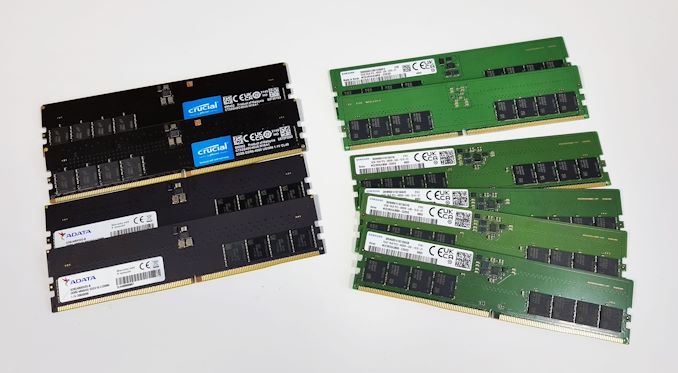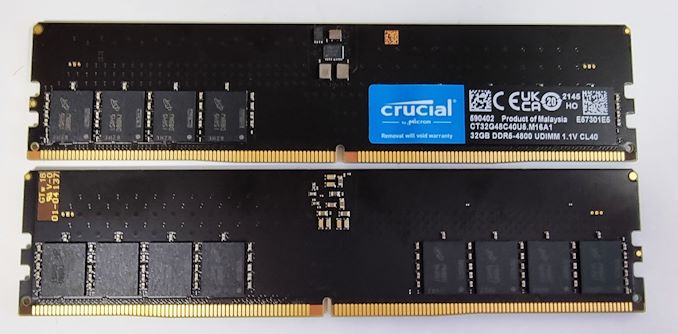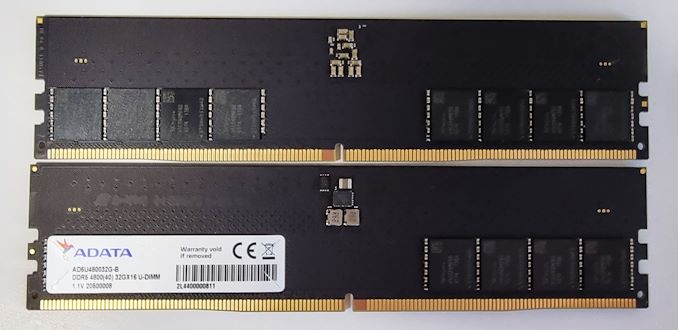DDR5 Demystified - Feat. Samsung DDR5-4800: A Look at Ranks, DPCs, and Do Manufacturers Matter?
by Gavin Bonshor on April 7, 2022 8:00 AM EST- Posted in
- Memory
- Intel
- Samsung
- Micron
- SK Hynix
- DDR5
- Alder Lake
- DDR5-4800
- 12th Gen Core
- Z690

The hottest advancement in memory technology for desktop computers in recent years is undoubtedly the release of DDR5 memory and Intel's 12th Gen Core series of processors. Not only does DDR5 memory yield higher memory bandwidth for many different use cases, but DDR5 also offers a generational increase in memory capacity, allowing for higher capacity UDIMMs over time.
But, as always, the memory market is anything but homogenous. Even with just three actual DRAM manufacturers, DIMM vendors are offering DDR5 at a slew of clockspeeds, both official JEDEC speeds and X.M.P. profile memory that essentially comes overclocked out of the box. There are also notable differences in today's common DDR5 DIMM configurations, including single-sided UDIMMs (1Rx8), and dual-sided memory (2Rx8), as well as UDIMMs with different capacities.
In today's piece, we're looking at DDR5-4800 memory from Samsung, including 2 x 32 GB, 2 x 16 GB, and 4 x 16 GB, to measure the performance differences between single and dual rank memory, as well as any differences between running DDR5 in one DIMM Per Channel (DPC) or two. Finally, as we have DDR5-4800 DIMMs with DRAM from Micron and SK Hynix, too, we'll also be looking at these in our results, to see if there are any performance differences among the three memory manufacturers.
Scaling With DDR5 Memory: The Story So Far
In December 2021, we tested the performance scalability of DDR5 memory using G.Skill's Trident Z5 2 x 16 GB kit of DDR5-6000 CL36 memory at a range of different frequencies. Our findings showed that going from JEDEC settings of DDR4-4800 CL36 up to DDR4-6400 CL36 yielded a performance gain of 14% when using one of our most memory-sensitive benchmarks, WinRAR 5.90. The consensus here was that using faster memory did allow for an uplift in practically all of the scenarios we tested. Still, the caveat was that due to the high prices of faster kits, there currently isn't any kind of price/performance sweet spot beyond current DDR5-4800 JEDEC kits – the price premium for high-speed kits is currently greater than the performance benefits.

Samsung DDR5-4800B CL40 memory (2 x 32 GB) (2Rx8)
Today's Test: Ranks, DPCs, and Do Memory Manufacturers Matter?
Since that initial article was focused on memory frequencies and latencies, we wanted to take a look at the other elements of the equation for DDR5 performance. This includes DIMM ranks, the number of DIMMs in a single memory channel, and even the memory manufacturers themselves. We've seen what happens when we play with the first two variables, now what happens when we play with the rest?
Focusing on DDR5 DIMM configurations, the DDR5 memory modules currently available for consumers using Intel's 12th Gen Core series come in four different combinations. This includes single rank (1Rx8) and dual rank (2Rx8) DIMMs, which in turn typically come in kits of two or four, making for 1 DIMM Per Channel (1DPC) or 2 DIMMs Per Channel (2DPC) respectively. And, as we'll see in our testing, both ranks and DPCs do impact DDR5 performance, so there is much more to getting the most out of DDR5 memory than just frequency and latencies.
The fundamental questions we want to answer in this article are:
- Is there a difference in performance between 1Rx8 and 2Rx8 with DDR5 memory?
- Is there a difference in performance when using 1DPC versus 2DPC (2x32GB vs. 4x16GB)?
- Is there a difference in performance between memory from different manufacturers at identical timings?
To explore the performance differences in of DDR5 operating in different ranks and DPCs, Samsung has sent over a collection of their latest DDR5-4800B DIMMs in two different configurations/capacities: 16GB 1Rx8 DIMMs, and 32GB 2Rx8 DIMMs. As one of the Big Three DRAM manufacturers, Samsung has an enormous presence in the memory market, but this is actually the first time the company has ever sampled consumer-grade UDIMMs. So we're excited to see how their own in-house DIMMs do in this respect.
With Samsung's DIMMs in hand, we've been able to test between the two different configurations, to see if 1Rx8 versus 2Rx8 is better from a performance perspective. We're also able to measure the impact of moving from 1DPC to 2DPC, an always interesting matter as DDR memory signaling has become increasingly difficult with each generation.

Crucial (Micron) DDR5-4800B CL40 memory (2 x 32 GB) (2Rx8)
Finally, as we already have 32 GB (2Rx8) kits from SK Hynix and Micron, this has also allowed us to do a true apples-to-apples comparison among different DIMM kits at stock JEDEC speeds. With JEDEC timings all memory should be equal, so this is the perfect opportunity to test and confirm that notion. Plus the additional DIMMs give us a good control to compare the performance of the Samsung DIMMs to, to make sure there aren't any Samsung-specific oddities going on.
Ranks & DPCs: A Quick Refresher
Looking at the configurations of DDR5 UDIMMs, there are two main types, 1Rx8 and 2Rx8. The R in the 1Rx8 stands for rank, so 1Rx8 means it has one rank with eight memory chips per rank. 2Rx8, in turn, means there are two ranks of eight memory chips. In practice, with today's DDR5 DIMMs, 1Rx8 will be a single-sided DIMM, whereas 2Rx8 is always dual-sided. We should note that there is also quad rank (4Rx8) memory as well, but this is typically found in servers and not usually meant for consumer platforms (where it may not even be supported to begin with).
Because the number of chips per rank is fixed – and so is the density of the first-gen DDR5 dies available today – the capacity of today's DDR5 DIMMs is directly proportional to the number of ranks. 32GB DIMMs are exclusively 2Rx8, using a total of 16 16Gb dies, while 16GB DIMMs will drop down to 8 of those dies.
And, of course, on most motherboards it's possible to populate either one or two DIMMs per Channel (DPC). Adding a second DIMM to a channel allows for doubling the total memory capacity of a system – going up to 128GB with today's systems – but it also comes with a potential performance tradeoff. Driving multiple DIMMs in a single memory channel is harder on the memory controller than driving a lone DIMM, which means going beyond two DIMMs can be a tradeoff between capacity and performance, rather than a means of increasing both. Which makes for a particularly interesting question right now when trying to build a 64GB system: is it better to go with two 2Rx8 DIMMs, or four 1Rx8 DIMMs?
Samsung, SK Hynix, and Micron DDR5 Manufacturing: The Differences
We have dedicated many column inches to DDR5 memory over the last couple of years; each memory manufacturer has its own process used to produce its memory ICs. Each different memory manufacturer also has its own manufacturing process and design application to create its dies for the memory chips.
| DDR5 Manufacturing Differences/Specifications (Samsung, SK Hynix, Micron) |
|||
| Manufacturer | Samsung | SK Hynix | Micron |
| Speed (MT/s) | DDR5-4800 | DDR5-4800 | DDR5-4800 |
| Bandwidth | 38.4 GB/s | 38.4 GB/s | 38.4 GB/s |
| Die Area | 73.58 mm² | 75.21 mm² | 66.26 mm² |
| Die Capacity | 16 Gb | 16 Gb | 16 Gb |
| Process Node | Samsung D1y | SK Hynix D1y | Micron D1z |
All of the DDR5-4800B memory we are testing in this article is what I like to call the 'early adopter DDR5', which means it's the using first iteration of DDR5 memory from each of the vendors.
On the early release silicon for DDR5 DRAM, each of its packaged dies measures up slightly different as each manufacturer uses its process. On the Samsung UDIMMs, it uses its SD1y node, with the die package area measuring at 73.55 mm². In contrast, the SK Hynix memory ICs measure at 75.21 mm² and uses that company's D1y node, while the smallest of the three is the Micron, with a package size of 66.26 mm² and is made using Micron's D1z node.
Looking forward, each of the Big Three is planning to use the latest in Extreme Ultraviolet (EUV) lithography to produce bigger, higher density, and faster dies in the future, many of which are already in early production. This includes the Samsung 14 nm node with EUV lithography, which should allow the mass production of DDR5-7200 memory (and hopefully, a JEDEC standard to go with it). Though as we're also dealing with the first generation of DDR5 memory controllers, the speeds attainable on Intel's 12th Gen Core, for example, are limited. When further advancements can be made, this should allow for faster DDR5 memory to be used in on future PC platforms.

ADATA (SK Hynix) DDR5-4800B CL40 memory (2 x 32 GB) (2Rx8)
Test Bed and Setup
Given DDR5 is a premium product, we have opted to use a premium platform for our test bed. This includes Intel's highest performing Core Series processor, the Core i9-12900K, and paired it up with a premium motherboard from MSI, the MSI MPG Z690 Carbon Wi-Fi. For our testing, we've left the Intel Core i9-12900K at default settings as per the firmware, with no changes made to CPU core frequency, memory frequency, or memory latencies.
For our testing, we are using the following:
| DDR5 Memory Test Setup (Alder Lake) | |
| Processor | Intel Core i9-12900K, $589 125 W, 8+8 Cores, 24 Threads 3.2 GHz Base, 5.2 GHz P-Core Turbo |
| Motherboard | MSI Z690 Carbon Wi-Fi |
| Cooling | MSI Coreliquid 360mm AIO |
| Power Supply | Corsair HX850 |
| Memory | Samsung DDR5-4800B CL40 (2 x 16 GB) - 1Rx8/1PDC Samsung DDR5-4800B CL40 (4 x 16 GB) - 1Rx8/2DPC Samsung DDR5-4800B CL40 (2 x 32 GB) - 2Rx8/1DPC SK Hynix DDR5-4800B CL40 (2 x 32 GB) - 2Rx8/1DPC Micron DDR5-4800B CL40 (2 x 32 GB) - 2Rx8/1DPC |
| Video Card | NVIDIA RTX 2080 Ti, Driver 496.49 |
| Hard Drive | Crucial MX300 1TB |
| Case | Open Benchtable BC1.1 (Silver) |
| Operating System | Windows 11 Up to Date |
Head on to the next page as we test the different DDR5-4800B memory kits and give our analysis.














66 Comments
View All Comments
DanNeely - Friday, April 8, 2022 - link
2DPC is much harder on the signal integrity; and only gets worse the higher the clock rate is. To the extent that several years ago there was some public speculation that DDR5 might not be able to support 2DPC at all.DanNeely - Thursday, April 7, 2022 - link
Secondary/tertiary timings generally need to be loser in 2DPC mode. The 4 dimm kit almost certainly has them set looser from the factory in XMP. Without using that (or if you combine a pair of 2 dimm kits) I'm not sure if official JDEC timings or the default BIOS behavior adjusts them down automatically or if you end up overclocking your memory trying to hold the tighter values. OTOH in the OCed timing case I'd expect it to either be about as fast as 1DPC or have stability problems (unless you're using high end modules and not taking advantage of the faster XMP settings for some reason).repoman27 - Friday, April 8, 2022 - link
AFAICT, we don't even know the primary timings here.It looks like the Crucial 2x 32GB kit was the only one in the test that had any XMP profiles. But we have no idea if the firmware defaults resulted in those being ignored, used, or possibly even used in conjunction with Intel Dynamic Memory Boost Technology. I believe Alder Lake also has System Agent Geyserville (SAGV), which is another mechanism that could potentially dynamically alter memory frequencies.
Ryan Smith - Thursday, April 7, 2022 - link
Gavin's out for the rest of the day. But once he's back in, we'll check and see if we have logs of those figures so that we can publish exactly what they were.Slash3 - Thursday, April 7, 2022 - link
That would be perfect. I suspect that the four DIMM kit was being set to looser tertiaries automatically by the BIOS, and it would be interesting to see a full ZenTimings / ASRock Timing Configurator style readout for each kit arrangement. The gap in tested bandwidth seems far too high to be a result of rank variance, even for DDR5.The Z690 compatible version of Timing Configurator can be had from the HWBot community page.
https://community.hwbot.org/topic/209738-z690-bios...
alphasquadron - Thursday, April 7, 2022 - link
I may be wrong but the Grand Theft Auto benchmark titles for 1080p and 4k may need to be reversed as it shows 4k low mode having 80 more fps higher fps 1080p max mode.tomli747 - Thursday, April 7, 2022 - link
"The R in the 1Rx8 stands for rank, so 1Rx8 means it has one rank with eight memory chips per rank. "I thought x8 means each IC correspond to 8 bit of the bus, so 1Rx16 only need 4 ICs to form a 64bit rank.
stickdisk - Thursday, April 7, 2022 - link
Please do overclocking. I understand why you don't think it proper to do so but I really want a trusted source to settle the debate between Samsung and Hynix for DDR5 OC. I have a feeling they are actually the same but the OC community has fallen for the idea that Hynix is better.Also please look into clearing up whether higher XMP kits are just price segmentation tactic for memory vendors to make more money or are actually better binned. I'm sure they are better binned at times but I am also fairly confident they charge more for what is just a kit with an OC and not a better bin. This information could help people save some money.
Getting information of memory IC differences being the biggest indicator of potential memory performance into the mainstream is invaluable. This is important because I see way to many people building $2000+ PCs worrying about CPU OC for up to 5% more performance and not worrying about RAM OC for up to 10% more performance. Mainstream people don't have their priorities straight because mainstream tech influencers don't know better.
Oxford Guy - Thursday, April 7, 2022 - link
The benefit of XMP is that ordinary people don't have to try to do manual RAM overclocking, which is too complicated to be worthwhile for most people — especially on less-expensive boards that simply refuse to post and require guesses and manual CMOS clearing with a screwdriver. If one has the luxury of a fancy board with highly-specific post codes on a display, a CMOS reset button on the back panel (and, optimally, the ability to simply switch to a different profile), and reliable bypass of unstable RAM settings automatically by the board (preventing no-post situations) it might be worth doing for some enthusiasts. I suppose some of the new software configuration programs help to reduce the pain of RAM tinkering. I would rather switch on XMP and that's that, particularly when the RAM vendor promises it will work with the board I'm using at that speed.Oxford Guy - Thursday, April 7, 2022 - link
With DDR4 there is a difference between a daisy chain layout and a T topology layout, in terms of which layout is optimal with 2 sticks of RAM (daisy) and which is optimal with 4 (T). Does that model continue with DDR5? Which layout does this MSI board use and have you tried the other layout to verify that the board layout is not a factor?